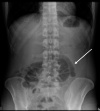Abdominal Cocoon Syndrome: A Rare Cause of Intestinal Obstruction
- PMID: 35399439
- PMCID: PMC8986506
- DOI: 10.7759/cureus.22929
Abdominal Cocoon Syndrome: A Rare Cause of Intestinal Obstruction
Abstract
Abdominal cocoon syndrome, also known as Sclerosing Encapsulating Peritonitis, is characterized by a fibro-collagenous membrane that involves abdominal viscera and it's a rare cause of intestinal obstruction. We present here two cases. Two male patients, 29 and 75 years old, were admitted to our emergency department with abdominal pain, vomiting, tender and painful abdomen but without changes in intestinal transit or peritoneal reaction. They were treated surgically and diagnosed with abdominal cocoon syndrome. Patients with abdominal cocoon syndrome usually present with recurrent episodes of intestinal obstruction, which result from the compression of the bowel within the constricting cocoon. Most of the time, this clinical picture resolves with conservative measures, delaying the diagnosis. The definitive treatment consists of excision of the membrane with lysis of adhesions, which is usually reserved for more severe cases of obstruction. This is a rare disease, where a high suspicion index is of paramount importance, especially considering that most of the diagnoses are made at the surgery.
Keywords: adherences; cocoon; encapsulation; intestinal obstruction; sclerosing encapsulating peritonitis.
Copyright © 2022, Frazão et al.
Conflict of interest statement
The authors have declared that no competing interests exist.
Figures





References
-
- Unusual small intestinal obstruction in adolescent girls: the abdominal cocoon. Foo KT, Ng KC, Rauff A, Foong WC, Sinniah R. Br J Surg. 1978;65:427–430. - PubMed
-
- Abdominal cocoon syndrome: preoperative diagnostic criteria, good clinical outcome with medical treatment and review of the literature. Solak A, Solak İ. Turk J Gastroenterol. 2012;23:776–779. - PubMed
-
- Abdominal cocoon: a surgical challenge. Vagholkar K, Doctor-Ganju K. Int Surg J. 2018;5:4090–4094.
Publication types
LinkOut - more resources
Full Text Sources
